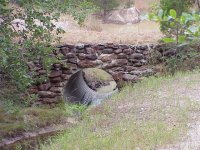Alan L.
Elite Member
I have a creek about 12 feet wide and pretty deep. The banks overflow once or twice a year. I want to do a bridge about 6 feet wide, something the kawasaki mule can cross, but mostly a walking bridge.
My plan had been to sink 2 large posts on each side, about 2 feet back from the bank, and build a frame to run I-beam or some other heavy timber across. The problem is, I'm afraid that when the water gets up, the water will want to wash out the dirt between the cemented posts and the creekbed itself.
When the water gets up, it doesn't seem to flow real fast, because its a very wide area that it gets into.
Anybody have any ideas?
My plan had been to sink 2 large posts on each side, about 2 feet back from the bank, and build a frame to run I-beam or some other heavy timber across. The problem is, I'm afraid that when the water gets up, the water will want to wash out the dirt between the cemented posts and the creekbed itself.
When the water gets up, it doesn't seem to flow real fast, because its a very wide area that it gets into.
Anybody have any ideas?



